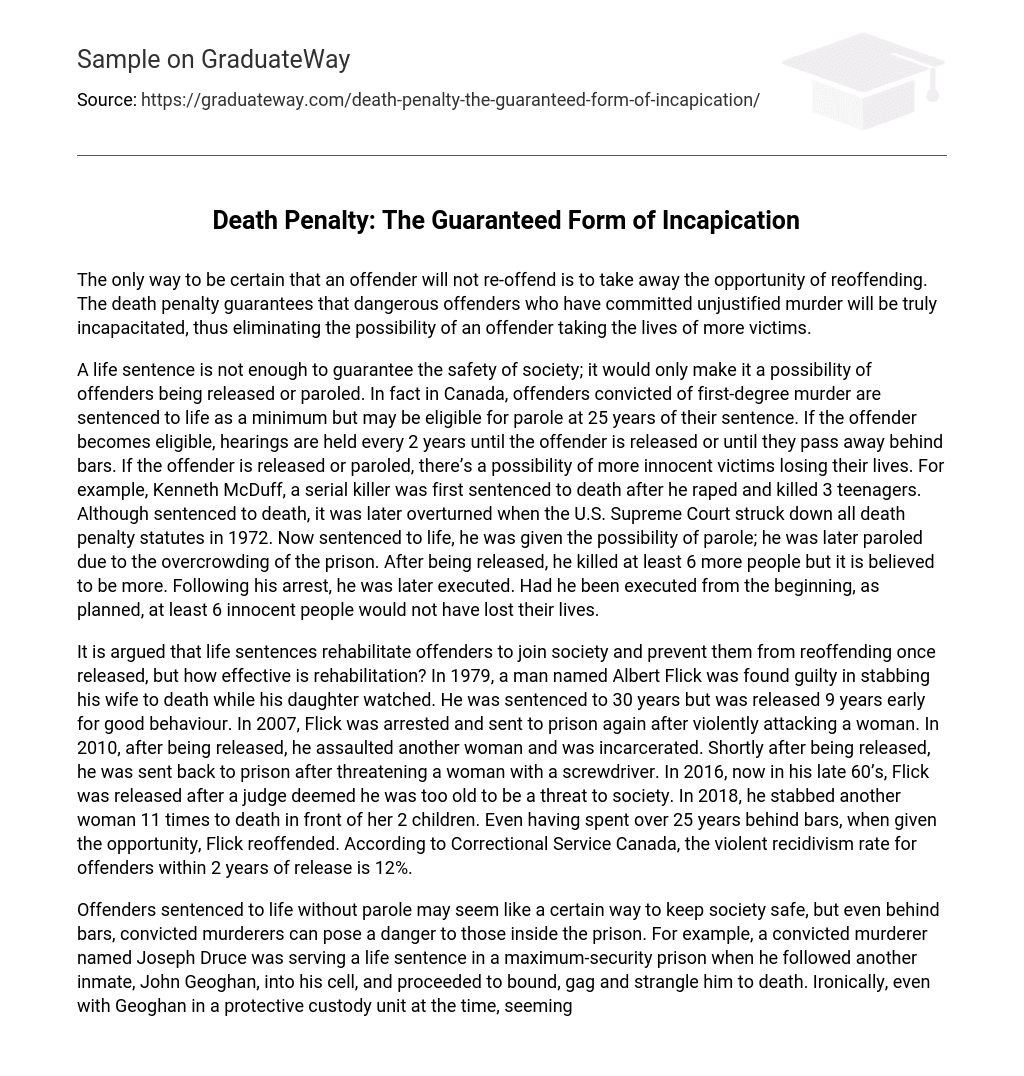The only way to be certain that an offender will not re-offend is to take away the opportunity of reoffending. The death penalty guarantees that dangerous offenders who have committed unjustified murder will be truly incapacitated, thus eliminating the possibility of an offender taking the lives of more victims.
A life sentence is not enough to guarantee the safety of society; it would only make it a possibility of offenders being released or paroled. In fact in Canada, offenders convicted of first-degree murder are sentenced to life as a minimum but may be eligible for parole at 25 years of their sentence. If the offender becomes eligible, hearings are held every 2 years until the offender is released or until they pass away behind bars. If the offender is released or paroled, there’s a possibility of more innocent victims losing their lives. For example, Kenneth McDuff, a serial killer was first sentenced to death after he raped and killed 3 teenagers. Although sentenced to death, it was later overturned when the U.S. Supreme Court struck down all death penalty statutes in 1972. Now sentenced to life, he was given the possibility of parole; he was later paroled due to the overcrowding of the prison. After being released, he killed at least 6 more people but it is believed to be more. Following his arrest, he was later executed. Had he been executed from the beginning, as planned, at least 6 innocent people would not have lost their lives.
It is argued that life sentences rehabilitate offenders to join society and prevent them from reoffending once released, but how effective is rehabilitation? In 1979, a man named Albert Flick was found guilty in stabbing his wife to death while his daughter watched. He was sentenced to 30 years but was released 9 years early for good behaviour. In 2007, Flick was arrested and sent to prison again after violently attacking a woman. In 2010, after being released, he assaulted another woman and was incarcerated. Shortly after being released, he was sent back to prison after threatening a woman with a screwdriver. In 2016, now in his late 60’s, Flick was released after a judge deemed he was too old to be a threat to society. In 2018, he stabbed another woman 11 times to death in front of her 2 children. Even having spent over 25 years behind bars, when given the opportunity, Flick reoffended. According to Correctional Service Canada, the violent recidivism rate for offenders within 2 years of release is 12%.
Offenders sentenced to life without parole may seem like a certain way to keep society safe, but even behind bars, convicted murderers can pose a danger to those inside the prison. For example, a convicted murderer named Joseph Druce was serving a life sentence in a maximum-security prison when he followed another inmate, John Geoghan, into his cell, and proceeded to bound, gag and strangle him to death. Ironically, even with Geoghan in a protective custody unit at the time, seemingly to protect him from the prison population, Druce was still given the opportunity to end a life. Between 2001-2011, 530 inmates died in federal custody and of those 530 deaths, homicide accounted for 5.5% (29 deaths).
No living murderer can be completely incapacitated and can pose a risk to both society and other inmates inside the prison. Why take the risk of more innocent people getting murdered when it can be prevented with the death penalty?





